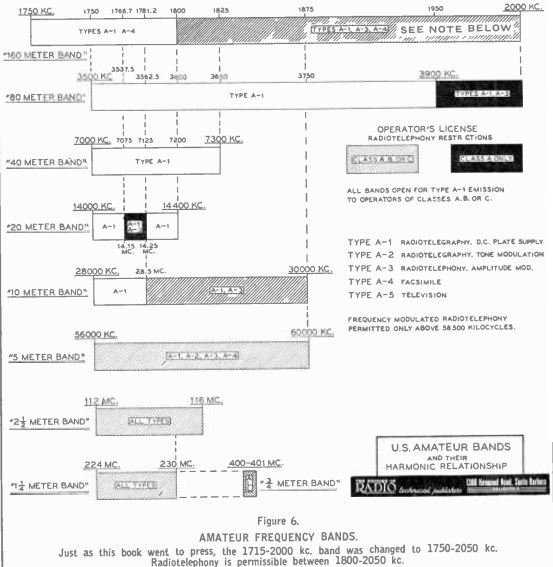This chart from 75 years ago, taken from the 1940 edition of the Radio Handbook, shows the bands available to U.S. hams in the days right before the war. The bands are recognizable, and 80 and 40 have the same band edges they do today. 160 meters had just undergone a shift. It is shown on the chart as covering 1715-2000 kHz, but the note at the bottom reveals that the band was expanded slightly to cover 1750-2050 kHz.
20 meters was slightly wider than it is today, extending up to 14.4 MHz, but 15 meters wasn’t assigned to amateurs until after the war. Ten meters was slightly larger than today, extending up to 30 MHz. As a compensation for losing the top 300 kHz after the war, hams were given the 11 meter band for about a decade until it was assigned to the CB service.
In the VHF spectrum, hams were assigned 56-60 MHz (5 meters), 112-116 MHz (2 – 1/2 meters), 224-230 MHz (1 – 1/4 meters), and 400-401 MHz (3/4 meters). The highest class of license (Class A) carried ‘phone privileges on 80 and 20 meters. All classes of license could use ‘phone on 160 and 10, while 40 meters was reserved for CW exclusively. Unlike today, the restrictions for lower classes of license related to mode only, and not to frequency. Class B and C licensees were allowed to operate on the 80 and 20 meter ‘phone bands, but they were limited to CW operation on those segments.
The bands above 30 MHz were open to all modes for all. FM was limited to frequencies above 58.5 MHz.
Interestingly, below 30 MHz, facsimile operation was permitted only on 160 meters, but was permitted by lower classes of license in the CW portion of the band.
The chart showed the harmonic relationships between the bands, and even noted the corresponding fundamental frequencies for particular band segments of the higher bands.
Click Here For Today’s Ripley’s Believe It Or Not Cartoon ![]()

